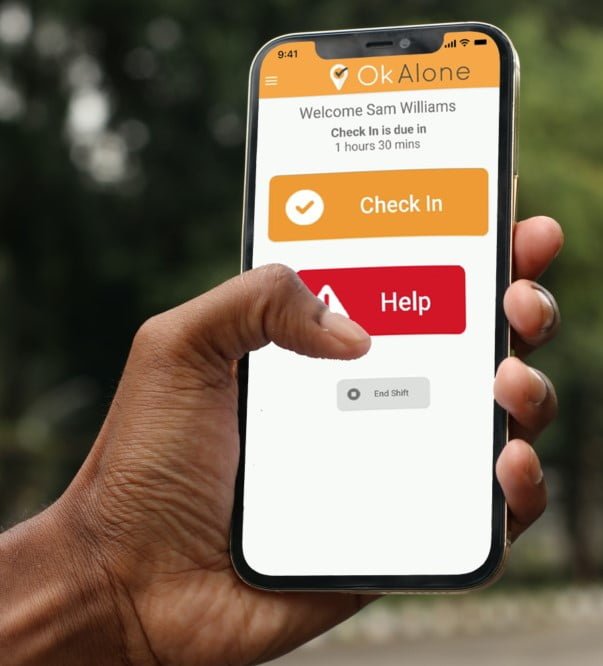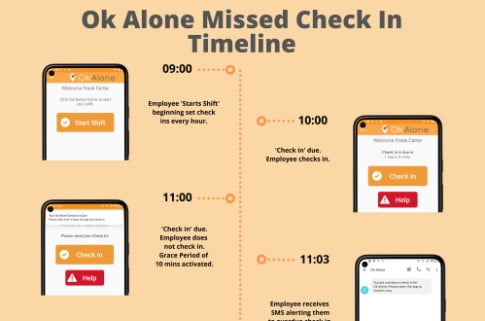The Ok Alone Guide to Escalation Procedures for Lone Workers

The Purpose of This Guide
Most health and safety laws include a special category for those who work on their own. These people are referred to as Lone Workers.
A Lone Worker can be defined as a worker that is in isolation from other workers without close or direct supervision.
Working alone is not a hazard on its own, but it does present a unique set of challenges. The purpose of this guide is to help you overcome these challenges by:
- Explaining the importance of an Escalation Procedure
- Providing a framework to create your own Escalation Procedures.
This guide provides a starting point for you to assess current safety measures within your work place and work towards a higher standard of safety for your lone workers.
What is an Escalation Procedure?
An Escalation Procedure is a clear, step by step set of instructions that can be used by other members of staff or an independent call centre to check that a worker is alright or alert others to a potential incident.
What is a Potential Situation?
Let’s say for example that John is a health worker who has gone on a home visit. His appointment ended at half past two and he was supposed to call his supervisor then to check in.
- Half past two passes without a phone call from John.
- No one notices John hasn’t called.
- John doesn’t get home for dinner; his wife thinks he is stuck in traffic.
- By seven o’clock John’s wife tries to ring John’s office, but it has closed for the day.
Where is John?
If John’s company was using an Escalation Procedure with the appropriate support from an automated app, it would have been noted within minutes that John had not checked in.
Using an Escalation Procedure
Let’s look at the scenario again.
John is a health worker who has gone on a home visit. His appointment ended at half past two and he was supposed to call his supervisor then to check in.
- Half past two passes without a phone call from John. The first step of John’s Escalation Procedure is activated and an independent call centre is alerted to John’s missed check in. An operator rings John’s phone. John doesn’t answer so the operator leaves the voicemail: "Hello John. You have missed a check-in. Please check-in to confirm you are okay." She calls John three times.
- John doesn’t respond, so step two is activated. John’s supervisor is phoned to inform her that John hasn’t checked in. The supervisor doesn’t answer her phone, so the operator leaves the voicemail: "Hello Lisa. John has missed a check-in. Please investigate this further." The operator calls Lisa three times. Lisa doesn’t answer.
- Step three of John’s Escalation Procedure is initiated. The operator calls John’s manager. The Escalation Procedure has specific instructions for the manager to go to John’s last known location, the address of his home visit. The operator informs Katie, the manager, that she is to proceed to John’s last known location.
- At three o’clock Katie arrives at the address of John’s last appointment. There she finds John at the bottom of the stairs where he’d fallen when leaving the residence.
Without an Escalation Procedure it took four and a half hours to realise that John was missing. Using the Escalation Procedure John’s manager was informed of his absence within 14 minutes and at his last know location in 30 minutes.
Creating an Escalation Procedure
When creating an Escalation Procedure decide if you are going to have a company wide version that applies to all staff or individual procedures with person specific instructions.
- Step One: Make sure you have up to date contact details for all your employees. A mobile phone number and an alternative number (home phone or personal mobile) if possible, would be best.
- Step Two: Decide who should be notified if the worker doesn’t check in. Their supervisor? A spouse? The Site office? How many times do you call? How many minutes apart?
- Step Three: Who is alerted if there is no response from Step Two? A line manager? An office manager? A shift manager? How many times do you call? How many minutes apart? Should someone go to the workers last known location?
- Step Four: Decide if someone on-site should contact the emergency services.
Pairing your Escalation Procedure with a check-in system that uses a Smartphone app and GPS locating will help ensure your employees are safe.
The benefit of an Escalation Procedure
We have found that a focus on the call delay time, the number of repeat contact attempts, the number of people in the contact list and a clear, easy to follow layout will have a much more profound effect on how quickly a situation gets escalated to emergency services should it ever be required.
Within the Ok Alone site (my.okalone.net) is a system to help you create clear and informative instructions for call centre operators to follow. The Escalation Procedure Wizard is designed to make the process of setting up your worker’s individual procedures as easy as possible.
Book a Demo Today
Alternatively, get a free trial of the app
Want to try OK Alone? Click the button below and enter your details. It's free and no credit card is required.




